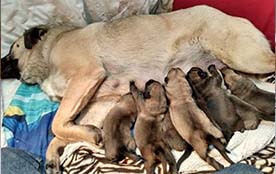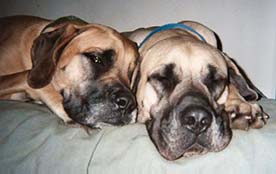Housebreaking Your American Mastiff Puppy
If you ask people to define "housetraining," you will, almost without exception, get some version of "housetraining is teaching a dog not to go in the house." That definition is INCORRECT !)
Read the following statement twice a day every day until your puppy is housetrained:
"Housetraining is KEEPING THE DOG FROM HAVING AN ACCIDENT in the house,
until the HABIT of not going in the house is firmly established."
Don't punish the American Mastiff puppy if s/he has an accident inside. It is your responsibility to make sure this does not happen, not the puppy's. A dear trainer friend of mine, when asked by clients, "What should I do when my dog goes to the bathroom in the house?" advises them to get an old newspaper, roll it up, and thump themselves over the head with it J . To avoid the need to abuse yourself in this way, follow this guide to housetraining in every detail, all the time, until you have a successfully housetrained dog.
If a puppy needs to go more frequently than every two hours and progress does not seem to be made in spite of proper application, have the pup examined by a vet, as there may be a urinary tract infection or, in the case of loose/frequent stools, parasites.
Keep in mind that each time your puppy is allowed to have an accident in the house, the process of creating the habit of going to the bathroom outside suffers a setback, and must begin again.
Normal cleaners will not clean up organic substances sufficiently to keep your puppy from detecting the scent and possibly repeating the mistake ("Hey, this smells like a potty area! I'll go here!"). You will need to purchase a gallon of either Nature's Miracle, Urine Gone or Pet-tastic and use as directed to eliminate the odor completely. (Trivia: Dogs can smell urine concentrations as low as 3 parts per million.) Spot Shot is another amazing product, removes order and stain instantly!
So how do you avoid an accident inside? It is simple, but because of modern lifestyles, not always easy. Here are the guidelines that make this program work: (note# you may need to carry your puppy to the "spot" first few days until puppy learns to lead.)
1) Take your American Mastiff puppy outside on the following schedule:
Immediately after it wakes up, whether in the morning or from a nap during the day;
Immediately after a play session. If play goes on for a while, take a potty break every 10-15 minutes;
If you see your puppy eating from his feeder, take him out immediately after puppy finishes eating.
2) In addition, be alert for signs the puppy needs to go out - circling, whining, or sniffing/looking for the "bathroom" - and when you see them, go out IMMEDIATELY. Always go to the same spot in the yard. Stand in that spot and pay no attention, give no pats, say nothing until the puppy goes.
The very instant the act of going is over, just as the little butt leaves the squat position to resume standing posture, praise warmly and give a small, yummy treat. Stay in the spot a few minutes longer (again, no attention, no pats, say nothing) in case the pup will go again. For puppies, pottying is often a two- or even three-step process.
Once potty time is done, play or walk around for 5-10 minutes or so before going in. Otherwise, your puppy may learn to delay pottying in order to stay outside longer. At this point, if in an enclosed area, if using a leash, it may be removed. Or even better, just drop it for the puppy to drag around, so that when it is time to go in, you can pick up the end of the leash again before calling the puppy to come inside. (Never waste a training opportunity!)
If your dog does not go when you are out, when you come back in CONFINE the dog for 45 minutes and then try again.
As your American Mastiff puppy gets older and/or better at letting you know when a potty break is needed, you may gradually extend the time between breaks. In general, a puppy can "hold it" for a number of hours equivalent to its age in months, plus one. Thus, an 8-week-old pup can typically go 2 to 3 hours between breaks, if at rest. By three months old, many can go all night, but still need a break before bedtime, upon waking in the morning, and each 3-4 hours during the day. Keep in mind that activity will prompt more frequent elimination, so the pup must still be given a break after play, eating, and waking up from a nap.
When you cannot follow the potty schedule or be vigilant for the signs your puppy needs to go out, you must confine the puppy. This is not being "mean" to your puppy, any more than it is "mean" to put a toddler in a playpen when it cannot be watched. Plus, it's just one of many things to which a dog must become accustomed in order to live successfully in the world of humans. If you teach them about this while young, it will be much easier on the puppy/dog and on you when confinement is necessary. *(see "puppy safe room" ) for long periods of time).
But for night time or two hours or less during the day we suggest the place of confinement should be small enough to prevent the American Mastiff Puppy "going" in one place, and then sleeping comfortably in a clean area (this takes advantage of their natural instinct not to soil the "den"). You might use a crate, an
exercise pen, or a gated-off corner of a room. Make it comfortable, provide a toy, treat and/or bone, and allow the dog access to it as a place to hang out even when not confined there. Don't use the area in a punitive manner. You want the dog to view it as a comfortable, safe den, and a place of
refuge. We do not suggest the small confined area for long periods of time such as your work day.
Sometimes a puppy will progress quite nicely for a while and then experience a setback or a period in which they seem to have forgotten everything you thought they had learned. This is normal. When this happens, just back up a step or two and work your way through the program again. And remember, how long you follow this program depends on how long it takes to housetrain your puppy. If the puppy isn't housetrained, keep doing the things outlined here until it is. Most of our adoptive families report back to us that their puppy housetrained within two to three days, some even less!
If your American Mastiff puppy does have an accident in the house, there are two courses of action:
If you did not see the accident happen, just clean it up and remind yourself to follow the rules! Take no action to correct the puppy -- s/he has long since forgotten it even happened and will not understand a thing if you try to remind/explain/correct. If you see an accident in progress, move quickly but calmly to pick the puppy up, take the puppy out to the chosen spot. Put the puppy down and follow the usual routine as outlined. In both instances, review the situation to identify where your application of the process broke down and adjust as needed to prevent the same mistake
in the future.
-

Please click here to learn about upcoming litters and puppies for sale.
Read more >> -

Please click here to see our personal breed dogs.
Read more >> -

Please click here to see our American Mastiff Puppy Care and training Guide.
Read more >>
